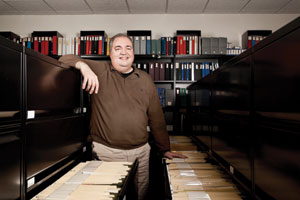Case authority
Mark Falzini ’91 is one of the foremost experts on the Lindbergh kidnapping, which took place 80 years ago this month but continues to fascinate people everywhere.

Mark Falzini ’91 is one of the foremost experts on the Lindbegh kidnapping case. All photos this page (c) Dustin Fenstermacher

Mark Falzini ’91, the archivist who oversees the New Jersey State Police Museum’s mountain of research connected to the Lindbergh kidnapping, has taken questions and requests from authors, academics, journalists, schoolchildren—even from the plain curious, including two retirees who visit the museum every month to pore over documents and swap opinions.
History tells us that Bruno Richard Hauptmann was executed in 1936 for the 1932 kidnapping and murder of legendary aviator Charles Lindbergh’s infant son, Charles Jr. Yet interest in this New Jersey-based factual drama has not waned in the 80 years since the Lindbergh baby was abducted, solidifying Falzini’s status as an investigative Sherpa.
Not that he minds. “That’s what it’s here for,” says Falzini, referring to the West Trenton, NJ, museum and its 250,000 documents, photographs, videos, and artifacts. Besides, Falzini, an insatiable history buff, is forever curious. “I’m still learning little tidbits,” he says,“because I’m always looking at things and thinking, ‘Oh, look at this…”

Falzini quickly learned why so many people become infatuated with the Lindbergh case when he began working at the museum in 1992.
“You have mystery, you’ve got the rich and famous, you’ve got the poor, you’ve got the immigrants, the illegal aliens,” he says. The kidnapping and subsequent trial, which took place in Flemington, NJ, were set against a historically rich backdrop that featured the Great Depression and the rise of Adolf Hitler. For Falzini, history is about telling stories, and the Lindbergh case, which he calls “America’s greatest soap opera,” has everything. Even better, the plot keeps thickening.
“You’re always finding new things,” he says, “because you’re looking at things with new eyes.”
To paraphrase Hauptmann, the book on this 80-year-old case has not closed. Theories abound regarding motivations and participants. Yet despite his expertise, Falzini, author of Their Fifteen Minutes: Biographical Sketches of the Lindbergh Case, doesn’t have a theory of his own.
“I’m exposed to so much information, I’m baffled,” Falzini explains. “And if I pick one thing I believe, then when someone else comes in [and] I go to help them with their theory, I’m going to be blocked. This way, by taking on their theory for the day, I’m better able to help them, but also, in a selfish way, I get to help myself and learn more.”
Lloyd Gardner, a professor emeritus at Rutgers, visited Falzini’s museum while researching his book The Case That Never Dies. “He knows so much more about the case than anyone else,” Gardner says of Falzini. “He is able to guide researchers without imposing his views on them. ”
Gardner adds that many archivists consider limiting outsiders’ access to materials part of their job. Falzini, “unfailingly kind and courteous,” actually offers research suggestions.
“He’s in a beautiful little spot where courtesy exists,” Gardner says.
Recently, that courtesy was extended to some Hollywood filmmakers. J. Edgar, Clint Eastwood’s 2011 biopic of controversial FBI director J. Edgar Hoover, features a segment on the Lindbergh kidnapping. Not surprisingly, Falzini and the museum played a role in what audiences saw onscreen.
Michael Sexton, the film’s property master, and his assistant, Kevin Shaw, met with Falzini in December 2010. The duo spent eight hours examining the evidence, shooting photographs, drawing sketches, and taking measurements. Several months afterward, Falzini helped Sexton and Shaw over the phone and through e-mail.
In the end, Hollywood sort of got it right.
“The props for the movie—the ladder, the wallpaper [in Charles Jr.’s room]—those were all accurate,” says Falzini. “Everything else, well, I don’t know. They screwed up William Allen, big time. They had a white guy portraying him…. I was really annoyed by that, because how could you make such a major mistake?” Allen, one of Falzini’s favorite figures in the case, was the African-American truck driver who discovered the corpse of Charles Jr. several miles from the Lindberghs’ Hopewell, NJ, home.
But the biggest oversight by the filmmakers? Falzini and the museum were not acknowledged in the movie’s credits.
“I don’t know why,” Falzini says. “But it was an honor to work on the film, and I would work with Mike and Kevin again in a heartbeat. They’re both great guys and fantastic to work with.”
Regarding his alma mater, Falzini remembers the College as being “the best time of my life.” He cites professors John Karras and the late Tom Faughnan with teaching him how to write and research, essential tasks in his line of work.
“A history degree at Trenton State prepares you for anything,” Falzini says.
“I’m damn lucky,” he adds. The reason why comes a few moments later: “I’m paid to work on my hobby.”
Posted on March 7, 2012

